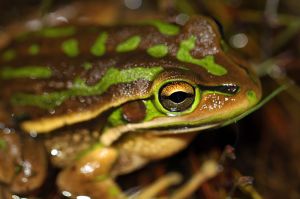As urban wetlands become more prevalent, Jayne Hanford and colleagues look into how other species, not just those of conservation focus, might benefit from our management efforts. What happens when those additional species could be problematic for nearby human populations?

Wetlands are one of the world’s most valuable but also most threatened ecosystems. The services they provide include biodiversity conservation, flood mitigation, water purification, and food production. And, while natural wetlands continue to be degraded or lost around the world due to agricultural and industrial pressures, the number of constructed wetlands in urban areas is on the rise, largely due the popularity of water-sensitive urban design and its cost-effectiveness for managing urban stormwater. Constructed urban wetlands can also provide valuable food and habitat resources to urban wildlife in what are often challenging, resource-poor environments. They can even support threatened populations such as the green and golden bell frog Litoria aurea (Sydney, Australia), western pond turtle Emys marmorata (California), ten different species of dragonfly (Central Europe), and the round-tailed muskrat Neofiber alleni (Florida).
Undesirable neighbours
Although mosquitoes are a small component of urban wetland ecosystems, nuisance biting and transmission of mosquito-borne pathogens can present a costly problem, have detrimental impacts on public health, and also undermine public support for conservation priorities within constructed urban wetlands. However, conservation and public health priorities are not necessarily incompatible. Design and management of these wetland systems can significantly impact potential mosquito risks, though many management regimes are untested.
Field testing wetland management
In our landscape-scale manipulative field experiment, we tested the ecological impacts of short-term wetland draining, such as that required for constructed wetland maintenance and management of invasive and threatened species. A group of urban wetlands were drained annually to reduce the abundance of the highly invasive plague minnow Gambusia holbrooki, and then refilled to provide a predator-free breeding habitat for the threatened green and golden bell frog Litoria aurea.

Our results showed that larval mosquito abundance was higher at drained and refilled wetlands compared to adjacent undrained wetlands, and that draining also had a significant impact on aquatic biodiversity – twice as many macroinvertebrates were collected from drained compared to undrained wetlands. Creating a fish-free habitat seems to be good for many invertebrates, specifically small crustaceans such as ostracods and copepods. However, some invertebrates were reliant on the availability of water, and more taxa were found exclusively in undrained wetlands compared to taxa found exclusively in drained wetlands. While differences in the macroinvertebrate community overall decreased over time, measures such as total macroinvertebrate abundance and taxa richness did not. In systems where constructed urban wetlands may be more isolated, i.e. there are few other available waterbodies nearby, an increase in larval mosquito abundance could lead to increased mosquito exposure and the potential conflicts this may cause with the surrounding community.
Thinking outside the (target species) net
Overall, our study highlights the challenge involved in managing urban wetlands for conservation, and emphasises the importance of considering impacts to non-target species, especially those that can adversely affect public health and wellbeing. It also demonstrates the need to evaluate urban wetland management regimes, including routine maintenance activities, especially as constructed wetlands become more common. Through considering potential effects on mosquitoes and taking pre-emptive action targeting geographically relevant species, practitioners can reduce human exposure to mosquitoes and associated negative impacts, and increase positive conservation outcomes associated with urban wetlands.
Read the full article, Management of urban wetlands for conservation can reduce aquatic biodiversity and increase mosquito risk, in Journal of Applied Ecology.
